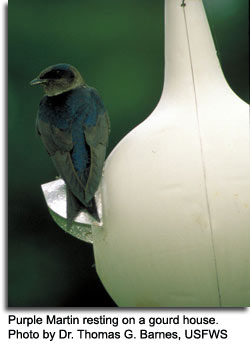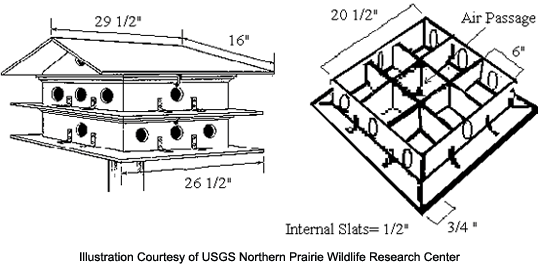
Natural History
Purple Martins are members of the Swallow family which historically nested in cliffs and hollow trees. However, east of the Rockies, Purple Martins are dependent on man-made nesting structures. They are also very likely to return to the same nest site used in past years. Martins are social birds which often nest in colonies. However, they will not tolerate House Sparrows or European Starlings in their colony.
In the spring, male Purple Martins arrive first to scout out potential nest sites. Once the females arrive, they start hunting for a nest site and a mate. After a female pairs with a male, 2 - 3 weeks may pass before a nest is built. Their nests are made of straw, leaves, twigs and mud. An average brood generally consists of 3-5 eggs, which are solid white. Female martins normally incubate the eggs; however, both sexes feed the young. Young martins remain in the nest for 28 - 35 days. After fledging, the young are still dependent on their parents for an additional 2 weeks and may even return to the nesting area during the night.
About three weeks after the young leave the nest (late July through August), martins begin migrating south. They congregate in huge flocks for the trip. Normally the adult males leave first, followed by adult females and the young hatched that summer.
Purple Martin Diet
One reason many homeowners welcome Purple Martins is due to the fact that their entire diet consists of flying insects, which they catch in flight. Their assorted diet includes dragonflies, damselflies, flies, midges, mayflies, stinkbugs, leafhoppers, Japanese beetles, June bugs, butterflies, moths, grasshoppers, cicadas, bees, wasps and flying ants. Contrary to popular belief, they do not readily prey on mosquitoes. Unfortunately, Purple Martins are extremely vulnerable to starvation during cool and rainy weather, when insects are low in numbers.
Purple Martins are powerful flyers and alternate short glides with rapid wing flapping while changing direction, often in the pursuit of insects. They have a special ability to fold their wings and dive like a ball from high in the sky right into their birdhouse door.
Attracting Martins
You can attract martins to your backyard by eliminating pesticide use and erecting nest boxes. Since martins feed on insects, using pesticides in your yard will eliminate their food sources which will make your yard less appealing to martins. Martins, like other birds, also need a source of fresh water. Martins will readily nest in boxes or communal houses, but the placement of these boxes is a key factor to martins taking up residence.
Martin nest boxes should be placed 30-120 feet from human housing in an open area. Generally, the more open the area (i.e. lack of trees), the better the area is for martins. The housing should then be placed on a pole at least 10 feet high but no more than 20 feet high. Predator guards should be placed on poles to discourage predators from raiding the nests. Erect or open houses in early to mid-May, approximately 4-6 weeks after scouts arrive in the area.
The
Purple Martin Conservation Society also has very detailed information on how to attract and tend to martins in your backyard. The information listed below is a housing design example for Purple Martins.

Materials
- 4' x 8' x 1/4" plywood
- 1" x 2" x 14" (base)
- 2" x 2" x 6" wood block
- 1" x 1" x 8" (corner blocks)
- 4" x 4" x 14" wooden post
- 1/2" diameter dowels (railing)
- 4" x 8" metal window screen
- 4" x 5" shelf brackets
- 10 1/2" x 5/8" aluminum rod
- 1/4" or 3/16" x 1 1/2" round head stove bolts
- 1" # 8 flat head wood screws
- 7d galvanized siding nails and 1" nails
- Carpenter's glue, Lightweight roofing paper
- Aluminum paint, White latex house paint
Construction
- Mark all pieces on a plywood sheet, and then cut out.
- Make all entrance holes into a 3" wide semicircle that is 1 & 3/16 " tall. The size of the hole is important to discourage European Starlings from using the nest box. The bottom of the entrance hole should be no more than 1/2" above the porch, and is most effective in excluding starlings when placed flush with the porch and compartment floor.
- Construct the base using 7d galvanized siding nails.
- Drill a 1/4" hole through the center for the metal rod. Drill a similar hole through the floor piece.
- Assemble the sides, alternating one and three-hole pieces. Use glue and three 1" nails on each end of each side.
- Mark the position of the sides on the floor and glue 1/4" x 1" x 1" blocks to floor in the four marked corners.
- Attach sides to floor with glue and 1" nails.
- Assemble and insert the partitions using glue.
- Position the ceiling piece, mark the corners and attach 1/4" x 1" blocks at the corners using glue.
- Drill a 1/4" hole through the center of the ceiling. Place ceiling in position.
- Glue three pairs of triangular roof supports together to form 1/2" thick ends and middle support. Attach the screen to cut ventilation holes.
- Attach the supports to the ceiling piece with glue and nails.
- Bevel one long side of each roof piece and attach to roof supports with glue and nails.
- Attach the floor piece to base with carpenter's glue and 1" nails.
- Cut the wooden block for chimney to fit the roof and drill a 1/4" hole through it and the roof to accommodate the rod.
- Nail chimney in place. Insert rod.
- Use 1/2" diameter dowels to make a fence about 2" high around balcony. Corner posts for the railing can be made from 1" x 1" x 3" of wood.
- Use the shelf brackets, stove bolts, and wood screws to attach the nest box to the pole. Set the pole 4' in the ground and secure by pouring a little cement around the base.
- Cover the roof with the roofing paper and paint with aluminum paint before painting the entire house white.
Invite Wildlife to Your Backyard!
For more information, please contact:
Maryland Department of Natural Resources
Wildlife and Heritage Service
Tawes State Office Building, E-1
Annapolis MD 21401
410-260-8540
Toll-free in Maryland: 1-877-620-8DNR
[email protected]
Acknowledgements:
- Purple Martin resting on a gourd house by Dr. Thomas G. Barnes, USFWS
- Illustration Courtesy of USGS Northern Prairie Wildlife Research Center